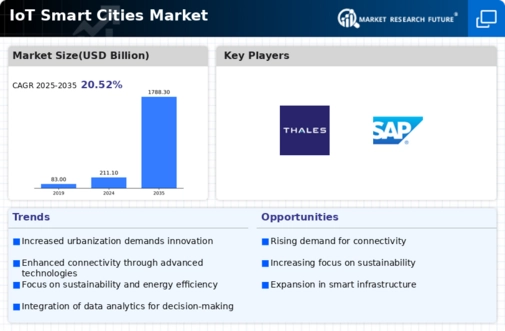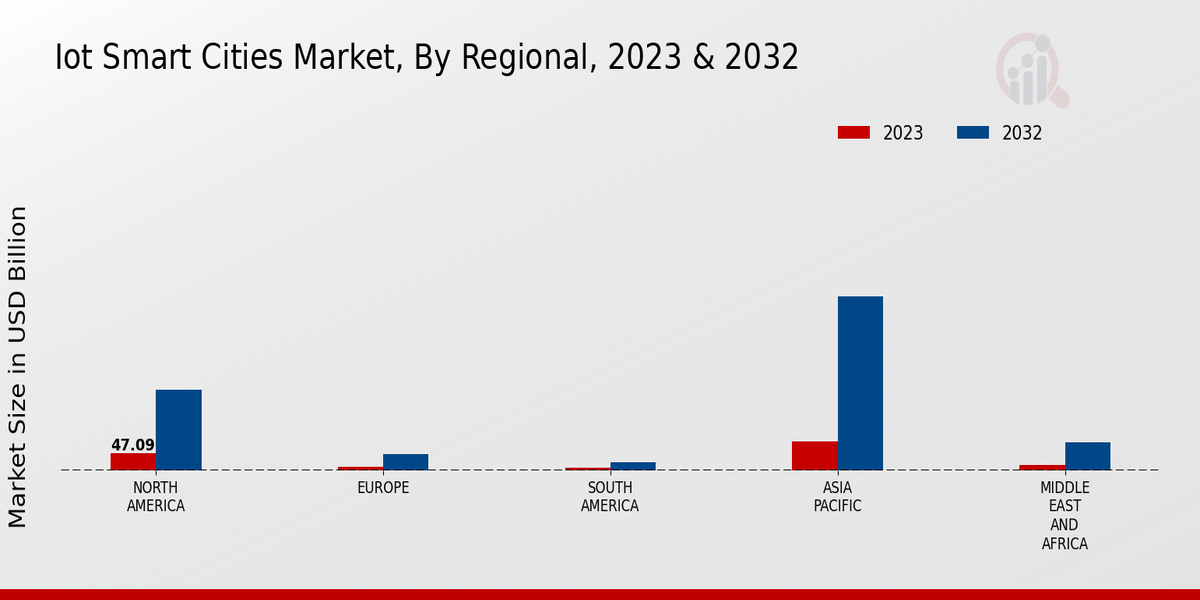Rising Urbanization
The Global IoT Smart Cities Market Industry is experiencing a surge driven by rapid urbanization. As more individuals migrate to urban areas, cities face challenges related to infrastructure, transportation, and public services. In 2024, the market is valued at 211.1 USD Billion, reflecting the increasing demand for smart solutions that enhance urban living. For instance, cities like Singapore and Barcelona have implemented IoT technologies to optimize traffic management and reduce energy consumption. This trend is expected to continue, as urban populations are projected to reach 68 percent by 2050, necessitating innovative approaches to urban planning and management.
Enhanced Public Safety
Public safety is a paramount concern for urban areas, driving the Global IoT Smart Cities Market Industry. The integration of IoT technologies in public safety systems enhances emergency response and crime prevention. For instance, smart surveillance cameras equipped with AI capabilities can analyze real-time data to detect suspicious activities, enabling law enforcement to respond promptly. Furthermore, connected emergency services improve communication and coordination during crises. As cities prioritize safety and security, the adoption of IoT solutions is likely to increase, further propelling market growth.
Market Growth Projections
The Global IoT Smart Cities Market Industry is poised for remarkable growth, with projections indicating a substantial increase in market value. In 2024, the market is estimated at 211.1 USD Billion, and by 2035, it is expected to reach 1788.3 USD Billion. This growth trajectory suggests a compound annual growth rate of 21.44 percent from 2025 to 2035. Such figures underscore the increasing investment in smart city technologies and the growing recognition of their potential to enhance urban living. The market's expansion reflects a broader trend towards digital transformation in urban environments, driven by the need for efficiency and sustainability.
Technological Advancements
Technological advancements are a crucial driver of the Global IoT Smart Cities Market Industry. Innovations in IoT devices, artificial intelligence, and big data analytics are transforming urban environments. These technologies enable cities to collect and analyze vast amounts of data, leading to improved decision-making and resource management. For instance, smart sensors deployed in urban areas can monitor air quality and traffic patterns in real-time, allowing for timely interventions. The integration of these technologies is expected to propel the market forward, with a compound annual growth rate of 21.44 percent projected from 2025 to 2035, highlighting the increasing reliance on advanced technologies in urban management.
Government Initiatives and Funding
Government initiatives play a pivotal role in the expansion of the Global IoT Smart Cities Market Industry. Various national and local governments are investing heavily in smart city projects to improve public services and enhance quality of life. For example, the European Union has allocated significant funds to support smart city initiatives across member states. These investments not only facilitate the deployment of IoT technologies but also encourage public-private partnerships, fostering innovation. As a result, the market is anticipated to grow substantially, with projections indicating a value of 1788.3 USD Billion by 2035, driven by sustained governmental support.
Sustainability and Environmental Concerns
Sustainability is becoming increasingly important in urban development, significantly influencing the Global IoT Smart Cities Market Industry. Cities are adopting IoT solutions to address environmental challenges, such as pollution and waste management. For example, smart waste management systems utilize sensors to optimize collection routes, reducing carbon emissions and operational costs. Additionally, smart grids enhance energy efficiency by monitoring consumption patterns. As cities strive to meet sustainability goals, the demand for IoT solutions is expected to rise, contributing to the market's growth and aligning with global efforts to combat climate change.













